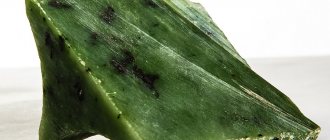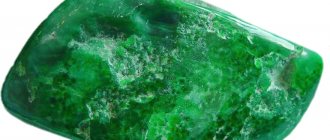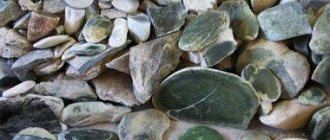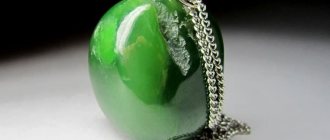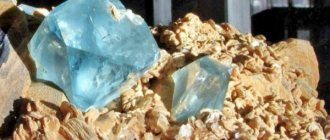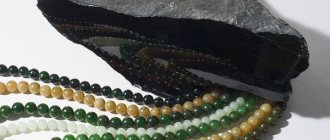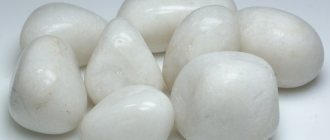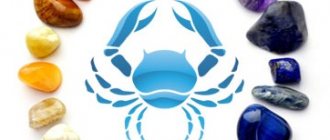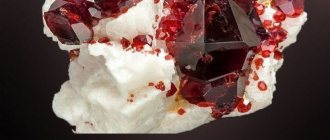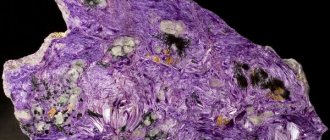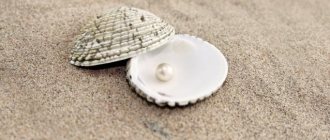Drinking from jade mugs was previously believed to help restore the kidneys. Jade (jadeite) is a semi-precious stone that is twice as strong as steel and 5 times stronger than granite. The stone owes its strength to the successful arrangement of crystalline fibers such as alkaline amphibole. Consists of silicate and actinolite mineral. Jade is so strong that it is almost impossible to split or break. That is why cave people made their “first” tools from this stone. Back in prehistoric times, jade became popular because of its durability and strength.
Properties of jade
Jade belongs to the silicate group of minerals and is an interweaving of amphibole fibers. A distinctive feature of this stone is its increased viscosity. It is quite difficult to break off a piece from a mineral. Jade weapons are almost as strong as steel weapons.
Due to its strength, jade belongs to the first class jewelry and ornamental stones. Depending on the texture, jade is divided into 3 groups: uniform, spotted, spotted-disseminated. The presence of stains depends on impurities of iron, manganese or chlorine. The color range of this mineral ranges from milky white to black. The most common shades are green with pink or yellow splashes.
Jade beads. Photo: fedpress.ru
Contraindications for treatment
There are no contraindications for the treatment of nephritis; it is absolutely harmless to people. Despite its complete harmlessness, jadeite has its own character. If the stone does not like the energy of its owner, it may “on its own” leave its owner, for example, get lost, darken or break. From an astrological point of view, contraindications exist for representatives of water signs - the stone can add pessimism and melancholy.
In the current market, you can choose jade of any color; it is sold in the form of keychains, jewelry, pyramids, pendulums and other products. The healing and beneficial properties of the stone are very extensive, even if you do not engage in professional lithotherapy - wearing it as a talisman is recommended!
How to distinguish natural jade from imitation?
It is not difficult to distinguish a natural stone from a fake if you use the following simple techniques:
If you lightly hit a jade on a coin or other jade item, the sound will be clear and resonant. If it is fake, then the sound will be dull and dull.
You can try leaving a scratch on the stone. In the case of real jade, this is almost impossible, and its imitation is easily subject to various physical influences.
Advertising - Continued below
You should also pay attention to the shine of the stone: jade after good polishing has a “greasy” shine, and an unpolished stone shows a matte velvety surface.
What are the benefits of jade for the human body?
The health benefits of jade lie in the physiotherapeutic effect of heated stones on human organs, tissues and blood vessels. Heating can occur either naturally or with the help of electricity in products equipped with conductors.
At the cellular level, increased movement of substances across the cell membrane is activated. Cell phospholipids receive additional antioxidant protection, which prevents membrane deformation. Reparative processes proceed faster due to the stress factor in the form of a local increase in temperature. Increased lymphatic drainage and microcirculation manifests itself on the skin in the form of redness. Congestion is eliminated, and physiological muscle relaxation occurs.
If a person experiences insomnia, physical therapy sessions using jade products will prepare the body for sleep by eliminating muscle spasms and tension.
Representatives of lithotherapy, one of the branches of traditional medicine, talk about the effectiveness of the stone against headaches and visual disturbances when worn constantly. People who want to speed up the detoxification processes in the body are advised to drink from a jade bowl or dip the stone into the drink before drinking it.
Magical and healing properties of jade
According to Chinese beliefs, this stone is the personification of five human qualities: honesty, justice, mercy, courage and wisdom. If a person with bad thoughts takes it, the stone will darken. Jewelry with this mineral can protect a person from the negative effects of otherworldly forces. So, for example, red jade will protect the owner from all fire-related troubles: fires, burns, etc. Also, constantly wearing a jade pendant will prevent the owner from bringing the evil eye or damage to the owner.
Red jade beads. Photo: ptitsabeads.livemaster.ru
A Khotan jade ring helps in achieving goals and preserves family happiness. If you have a jade figurine in your house, then everything you plan will be accomplished faster and easier, but only as long as your goals are noble.
Advertising - Continued below
The healing properties of jade are also extensive. Massage with jade plates can relieve pain and heal sprains, bruises and dislocations. This stone also helps in getting rid of various infectious and gastrointestinal diseases. It has a beneficial effect on a person’s sleep, relieving nightmares and insomnia.
What does jade stone cure?
"Nephros" means kidney in Greek. In ancient times, people believed that the healing properties of jade could get rid of kidney diseases and reduce the intensity of renal colic. Now there are standard methods for treating pyelonephritis and glomerulonephritis, but you can also add contact massage to the main therapy by applying a smooth jade plate to the kidney area, followed by wrapping it in a warm woolen scarf. These activities are carried out exclusively after consultation with the attending physician.
Neurological diseases, in which physical therapy is used to relieve pain, are also areas of application for jade stones. Various massagers, mats, pillows, jade mats and other devices have been created that allow directing thermal energy locally. The healing properties of jade stone make it possible in the long term to reduce congestion in the affected area, which are part of the pathogenesis of osteochondrosis of the cervical and lumbar regions.
Which zodiac signs are jade suitable for?
Astrologers recommend wearing jade jewelry for people born under the sign of Virgo and Taurus. They will always be lucky in any endeavor. So, if Taurus wears a jade bracelet on their right hand, then they are guaranteed longevity, and in this case Virgo will experience great family happiness.
In addition, jade can be worn by Aquarius and Gemini.
But it is categorically not recommended for signs of the zodiac of the water element to wear jewelry with jade: Cancers, Scorpios and Pisces can become despondent from the excessive suppressive and stabilizing effect of the stone.
Rules for using jade for therapeutic purposes
For the best therapeutic effect, you need to know how and under what conditions jade has a positive effect on the body. The first thing a stone needs is a heat source. The human body can play its role. In this case, the stone is applied to the diseased area and wrapped in a wool scarf. Heating will occur due to the insulation of the stone by the canvas. However, it is worth understanding that in this case the difference between the surface of the body area and the coolant is insignificant, and the effect of the procedure is small.
Taking this feature into account, combined devices were created in which the stones are heated from an electric heat source. Then the temperature difference allows the body to give an intense response, which will be a therapeutic effect.
Contraindications to treatment for nephritis. There are no contraindications to wearing decorative elements with jade. If we are talking about a full-fledged physiotherapeutic procedure, then it is worth understanding: jade realizes its beneficial properties only when the stone is heated to 50-60 degrees Celsius. In case of pathologies, heating the affected area is prohibited, as it can cause a deterioration in the person’s condition. These include:
- Oncological diseases;
- Fever;
- Hyperthyroidism;
- Systemic lupus erythematosus;
- Infectious diseases;
- Strokes;
- Heart attacks;
- Weeping eczema;
- Purulent processes;
- Chronic diseases of organs and systems in the stage of decompensation.
Also a contraindication is discomfort when using jade products. During the first treatment session, there may be a slight tingling sensation that goes away after a couple of minutes, but if the discomfort increases, it is better to choose another method of physical therapy.
Occurrence and production locations: all over the world
There are jade deposits in different parts of the world, and most of them are still far from depleted. One of the most ancient suppliers of this stone is Burma. It is also mined in China, India, New Zealand, Mexico, Brazil, Canada, and the USA. Deposits are also known in European countries: Poland, Germany, Switzerland, Italy.
In Russia, greenish-gray jade was found in the Southern Urals at the beginning of the 20th century. Today, deposits of this mineral are known in Transbaikalia, in the Polar Urals. White jade was discovered in Buryatia; stones of this color are quite rare and highly valued
Jade: medicine or symbol?
In China, the name jade (yu) did not have a pronounced therapeutic connotation, although the use of, for example, jade plates for medicinal applications was discussed in many medical works. But the sacred, symbolic role of jade has received much greater recognition. It was in Northeast Asia that the use of jade in human history became most widespread. It is becoming a highly revered and enduring cultural symbol in many countries in the region (primarily in China itself). As one of the authors of this article believed, jade as a symbol of the highest perfection was chosen by representatives of the Mongoloid race, while Caucasians chose gold (Tan Chun, 1998).
Mongoloid peoples generally had no aversion to gold and readily used it both for decoration and as treasure, but along with jade, which was revered as a more refined and valuable mineral. Sometimes they write that this unusually cool (for Europeans) attitude towards gold is explained by its rarity. Indeed, no large gold deposits have been identified on the territory of modern China. But there was very little quality jade. The most valuable varieties, milky white and emerald green (jadeite), were brought from afar, from Khotan and Burma, respectively. So the basis for the veneration of jade in East Asia was not geological, but ideological. Gold was simply a material value, while jade was also a symbol of all virtues. However, the practical Chinese were not averse to combining the material and spiritual. So, wishing someone good luck and prosperity, they said (and say): “Jin yu man tan!” (“A house full of gold and jade!”)
The comprehensive study of jade products, begun by Professor Tan Chun back in the 1990s, inevitably led him to the problems of transcontinental contacts and migrations, the formation of new ideas and approaches in both the technological and aesthetic spheres. To solve these problems, it was necessary to maximize the use of both accumulated materials and intellectual support from scientists who studied “jade cultures” in the countries of the Asia-Pacific region.
Application
Both in ancient times and now, quite a large number of people use jade to treat certain diseases and ailments. There are several tips that are best followed:
- Small beads can be used as exercises after a stroke. The ideal option is jade beads.
- Using a massage ball, roller and jade rod in combination will help get rid of problems with facial skin and fatigue.
- Green stone will help stabilize the heart and improve sleep. Beads are best suited for this.
- A slightly heated mineral can be applied to bruises.
Talismans
Jade is an excellent amulet that protects a person from misfortune and wrong decisions. White stone brings change and good fortune. It is often used by people who want to find their soulmate.
A small lock, which is carved from stone, is used as a talisman for children. You can put it on a chain and give it to a child. This way evil spirits will not be able to approach him.
Rings with a white stone are used as a talisman to preserve family happiness and success at work. Moreover, this mineral will help improve the effect of other amulets. The setting for the stone is mainly silver.
Jade is a symbol of intelligence and courage. If you wear such a talisman constantly, then a person can easily achieve his goal. It will give intelligence and courage to warriors, and will also protect them from injury and wounds.
It is best to use red stone for your home. It will protect you from natural disasters.
Stone care
Caring for jade is very easy because it is not picky. The original stone is not afraid of scratches and falls.
It is enough to store it in a separate soft bag, case or box. When cleaning, it is better to give preference to a soap solution without aggressive agents, and then rinse well under running water. You need to wipe the stone dry.
You can wipe jade jewelry with a damp soft cloth.
Recommendations
- Students are recommended to take a talisman to exams - it will promote clarity of thinking, give peace of mind and good luck.
- The jade talisman helps fight premature vision loss. If you feel tired, just look at the pebble for a few minutes - this will allow your eyes to relax and rest. In a similar way, the talisman can be used for meditation.
- The jade talisman promotes change and transformation. It can be worn by anyone who wants to make changes in their life, expand their opportunities and horizons. Wear it when starting something new or breaking old habits.
- A magic pebble will help maintain spiritual closeness in the family (to do this, it is recommended to purchase a jade figurine and place it in the most visible place in the house), but it cannot be used to attract a couple or seek carnal pleasures. This is a spiritual talisman - use it for self-improvement, and everything else will come to you by itself.
- If you have trouble sleeping or are prone to nightmares, wear jade jewelry at night or place a small figurine under your pillow - very soon your sleep will become calm and sound.
- When faced with a serious problem that requires an extraordinary solution or difficult choice, retire for an hour to meditate with your talisman. The ideal option is to finger the jade rosary at this time, but in the absence of one, you can simply hold the pebble in the palm of your hand. Just follow your breathing and soon the right decision will arise in your mind.
- A jade talisman will be an excellent gift choice for a friend or loved one. This pebble itself symbolizes the wish for happiness, goodness and spiritual well-being, but presented as a gift, it has special power - it strengthens friendships or family ties, cleanses them of negativity and old grievances.
Crazy for the red blue white and yellow…
The earliest evidence of jade processing was discovered in Siberia, on monuments that date back to the Upper Paleolithic era (the settlement of Malta in the Angara region). This tradition is further developed in the Baikal region, where huge reserves of jade raw materials are concentrated; Moreover, at the stage of the Neolithic Serov culture (5500-4300 years ago), tools made of green jade predominated, and at the Glazkovsky monuments of the Bronze Age (4000-3600 years ago) - mainly rings and disks made of white stone. At the same time, white jade jewelry of the “Glazkovsky” type in the Bronze Age spread over a much wider territory, from the banks of the Oka to the Amur basin, but whether they originated from a single center or arose convergently in different cultures, this question remained debatable.
As for the territory of China, the earliest finds there relate to the Neolithic cultures of Xinglongwa (8200-7200 years ago) and Hongshan (ca. 6600-4900 years ago), discovered on the territory of Dongbei (although recently more ancient jade jewelry - up to 10,000 years ago, but so far they are single). The most valuable items were made from yellowish-green jade, most likely from Xiuyan, the only known deposit in this region.
The cultic attitude towards jade in China received an ideological justification and was consolidated by the authority of Confucius. In the treatise “Xunzi” (compiled in the 30s of the 3rd century BC), the following statement is attributed to him: “Here is jade, it can be compared with the virtues of a noble man,” after which a completely accurate and recognizable description is given the most significant properties of the mineral. The soft shine matches the humanity; hardness, amenable to grinding - knowledge; sharpness that does not hurt - action; inflexibility under pressure – courage; the obviousness of possible flaws - sincerity; a pure sound that is heard far away and fades away naturally - to the word. Jade pendants shining like virtuous humanity are mentioned in Wang Yi’s (89-156) commentary on the classic collection of poetry “Chu Stanzas” and in some other works of the Ancient World and the Middle Ages (Yang Boda, 1997; Wang Yanchong, 1998)
At the same time, items made of white jade found in Heilongjiang Province were probably of Baikal origin; Professor Shimpei Kato pointed out this possibility back in 1998. Contacts could be made along the banks of the Amur. Jewelry made of white translucent jade is also found in Inner Mongolia, Jilin and Liaoning provinces, especially on monuments of the early Bronze Age. It should be noted that the raw materials for their manufacture are unlikely to be of local origin, since stones of this color are not found at the Xiuyan deposit.
It was in the Xinglongwa burial ground that the earliest jade items in China were discovered - large pendant earrings in the shape of a ring with a cut (jue), which in subsequent eras spread from Yakutia in the north to Vietnam in the south. On the territory of Manchuria, they continued in the Hongshan culture, transitional from the Late Neolithic to the Early Metal (ca. 6600–4900 years ago). Particularly rich finds were discovered in the cult site of Niuheliang (Liaoning Province), in the vicinity of the so-called Temple of the Goddess. The decorations were given the shape of a dragon curled into a ring with the face of a fantastic beast. According to the Novosibirsk archaeologist S.V. Alkin, the figurines curled up in a semi-ring depicted the larvae of some types of insects as the embodiment of the entomological layer of ancient mythology (Alkin, 1995; 2003). Indeed, insects, whose life cycle took place in different environments and through several radical metamorphoses, could symbolize the most important mythological function of transition (from one world to another). However, in our opinion, the identification of jade figurines with a dragon, an initially multi-component image that continues the image of a serpent in mythology, but in combination with the characteristic features of other animals (including insects), deserves no less attention. The combination of different features in one mythological symbol prevented its correlation with any one real animal
At one time, Chinese scientists discovered that most geochemical techniques (such as X-ray diffraction, infrared and Raman spectroscopy, etc.) do not make it possible to confidently distinguish the sources of jade inside China. Russian experts came to more or less similar conclusions. Therefore, it is important to visually determine the color, as well as the transparency of the mineral according to the accepted scale (the color range is dominated by various shades of green and white, but there are also yellow, azure, reddish and even black stones).
Philosophy of stone
For many peoples, the symbolism of jade has a similar meaning. Its unique shine and smooth surface are compared to spiritual riches, sincerity, and kindness. Having sharp edges, the pebble does not hurt those who touch it - this symbolizes justice and generosity. It is called a symbol of humility, moderation and peace - the calm power of the Earth is concentrated in it.
Its melodic sound is called heavenly music, comparing it with the highest joy and subtle energies. This mineral symbolizes sincerity and directness - its entire structure is in plain sight, revealing to the world intricate patterns on a smooth surface. The latter also means that any flaws are relative - the disadvantages of color are at the same time the advantages of jade.
History and deposits
The name of the mineral comes from the Greek “nephros”, which means “kidney”. This is because jade pebbles are similar to this human organ. It is a semi-precious ornamental stone.
In the Neolithic era it was used to create weapons, tools and religious paraphernalia. Later, people began to make jewelry, decorative items, and household items from the material.
In the cultures of China, Tibet, Egypt and other countries, this stone enjoyed special respect. In China, it is considered sacred due to its many positive properties, which is why another popular name for the mineral is Chinese stone.
Jade is formed in an amazing way when magma from a volcano combines with rock. Main deposits:
- Russia (Republic of Tuva, Ural and other places);
- New Zealand;
- USA;
- Canada;
- China;
- Mexico.
Samples found in New Zealand are of high quality and original colors. This explains why the Maori (the indigenous people of the islands) valued this material very much.
